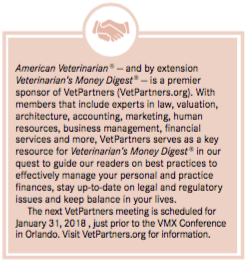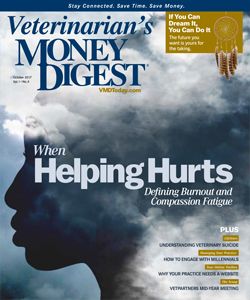VetPartners Mid-Year Meeting: Stepping Up Our Game
In July 2017, the VetPartners MidYear Meeting convened in Indianapolis, Indiana, and the agenda included two sessions on one very timely topic: diversity.

Twice a year, VetPartners meets to discuss current topics affecting the veterinary industry, veterinary schools and veterinary practices. In July 2017, the MidYear Meeting convened in Indianapolis, and the agenda included two sessions on one very timely topic: diversity.
Inclusion of the LGBTQ Community
Mike Chaddock, DVM, EML, associate dean of administration at Michigan State University College of Veterinary Medicine and vice president of the Lesbian and Gay Veterinary Medical Association, presented an overview of the current status of the LGBTQ community within the veterinary industry. Patterson Veterinary sponsored the presentation, which was moderated by training specialist Shelley Johnson, BS, CVPM.
During the session, Dr. Chaddock provided data indicating that the veterinary industry can do much better with regard to its attitudes and actions toward LGBTQ veterinary professionals and clients, and he offered suggestions for achieving that goal. Inclusiveness, he said, is beneficial not only to veterinary practice employees but also to a practice’s bottom line.
Veterinary Professionals

According to survey research, Dr. Chaddock said, only 48 percent of individuals who self-classify as LGBTQ disclose that information to their employers.1 Closeted employees also report significantly greater dissatisfaction with their rate of career advancement, are less likely to trust their employer and are much more likely to leave their company within three years.1 This low rate of openness may be due in part to the fact that 29 states do not protect employees from being fired as a result of sexual orientation.
Data show that discrimination against LGBTQ employees has negative consequences for those workers’ mental and physical health.2 Discrimination of one type also implicitly legitimizes other forms of prejudice and discrimination. It follows logically that employees who are comfortable revealing their LGBTQ status will be healthier, happier and perform better at work.
What can practices do to demonstrate their acceptance of all types of employees to current and future veterinary team members? It starts at the top, with the owner showing a commitment to running an LGBTQ-supportive hospital. Recruitment efforts can go beyond merely describing the practice as “an equal opportunity employer” and explicitly state that it has a nondiscrimination policy with regard to sexual orientation and gender identity.
Practices may also consider offering diversity training, using a wide range of suppliers that include companies owned or controlled by minorities of all kinds and marketing to and participating in LGBTQ community events and organizations. Dr. Chaddock noted that while practices that do not have any LGBTQ employees may believe they would not be welcome at LGBTQ events, the opposite is true. “There are fewer of us,” he said, “so we welcome all the community support we can get.”
Pet Owners
Veterinary hospitals may be missing key opportunities to win new clients, Dr. Chaddock noted. An estimated 78.5 percent of individuals who self-classify as LGBTQ own a pet, he said, and 75 percent report loyalty to service providers who are friendly to LGBTQ individuals.3 “We ask our friends about businesses in the community that are inclusive,” Dr. Chaddock said. “If they’re not, then my community is generally not going to frequent those businesses often.”
Veterinary practices can demonstrate friendliness toward the LGBTQ community by placing a rainbow sticker in a window or reception area. “That sends a strong message to the LGBTQ community,” he said, “and those who are not LGBTQ individuals are not going to be offended by it.” A selection of lifestyle magazines in the lobby area also makes a statement about inclusiveness.
Dr. Chaddock noted that open-ended client documentation will be perceived as more welcoming, such as replacing the word “spouse” with “partner” on intake forms. He also asked that practices with websites consider adding a statement about their inclusivity, because the lack of one sends a negative image. “Silence is communication,” he said.

Improving Ethnic Diversity and Accessibility
The veterinary profession is the least diverse of all health care professions, according to James (Jim) Lloyd, DVM, PhD, dean of the University of Florida College of Veterinary Medicine, and data show that this lack of diversity may be affecting the care of animals in the United States, as well as the makeup of the profession.
Serving the Underserved
In his talk about market segmentation, Dr. Lloyd reported on a study that looked at pet spending over 25 years from 1980 to 2005. Study data showed that 50 percent of animals in U.S. pet-owning households received veterinary care in 1980, compared with only 30 percent in 2005. Notably, he said, “those households that continued to spend money on their pets were spending substantially more than in previous years.”
Not surprisingly, study results also showed that pet owners who were more likely to incur veterinary expenses were older, owned their own home, earned more money and had a higher education level. What was less expected, Dr. Lloyd noted, was that “after correcting for various demographic factors, the study showed that people of color were 8 percent to 12 percent less likely to seek veterinary services for their pet than white pet owners [were].”
As the divide between financial classes has become more dramatic, he noted, veterinary services have continued to be available to middle- and upper-class pet owners but have become less available to the lower classes and those near or below the poverty line.
One opportunity to address underserved animals would be to create a business model that can service lower-income households. Often, veterinarians worry about nearby nonprofit veterinary clinics, but data have not substantiated this concern. Low- or no-cost services enable clients to have their pets cared for, often for the first time. These clients would not seek these services normally, so this population is naive to veterinary care.
Services provided may include basic vaccinations, neutering and pain control. Reducing disease, unwanted litters and pain benefits all animals in an area, whether the treatment occurs in a traditional or nonprofit clinic. All people and pets deserve care and love, regardless of income or social status. Providing low-cost services can be profitable and satisfying.
Diversity Among Veterinary Professionals
Additional data from 2005 indicated that 35 percent of the population at that time was nonwhite, whereas only 15.8 percent of veterinary students were nonwhite. The veterinary industry, Dr. Lloyd said, needs to do a better job of recruiting students of color. An estimated 70 percent of veterinary students report that they chose their career by age 15. This indicates that the profession needs to reach out to children well before that age to create enthusiasm about becoming a veterinarian.
After graduating, many new veterinarians return home or move to an area close to where they grew up. One theorized method of getting veterinarians into underserved communities is to recruit in those communities. Outreach and education may be performed on a personal or community level, and exposure to veterinary services may generate interest among children who had previous experience with veterinarians.
The University of Florida College of Veterinary Medicine is taking a unique approach to this issue. According to Dr. Lloyd, Florida suffers from a shortage of veterinarians in particular communities, such as within the southern urban centers. The college plans to open an extension of its teaching facility in the Miami-Dade area to provide services to the community and to offer outreach and support. South Florida has a large Hispanic population, yet few Hispanic individuals apply to veterinary school.
Current data show that the incoming class of veterinary students at the university is 79 percent white (21 percent minority) and 80 percent female (20 percent male). While these shifts are an improvement over the 2005 data, they still do not match the makeup of either Florida or the United States as a whole. Dr. Lloyd noted that the veterinary industry — and the animals we care for — may be better served by a diverse population of veterinarians who more closely mirror the diversity of the country.
Dr. Landis-Hanna, a 2002 graduate of Auburn University, has practiced small animal, exotic, shelter, and relief medicine. She was a medical director at VCA for 7 years and served as director of veterinary medicine for Voyce. She is currently the senior manager of veterinary outreach for PetSmart Charities.
References:
- Hewlett SA, Sumberg K. For LGBT workers, being “out” brings advantages. Harv Bus Rev. 2011;89(7-8). https://hbr.org/2011/07/for-lgbt-workers-being-out-brings-advantages.
- King EB, Cortina JM. The social and economic imperative of lesbian, gay, bisexual and transgendered supportive organizational policies. Ind Organ Psychol. 2010;3(1):69-78. doi: 10.1111/j.1754-9434.2009.01201.x.
- G/L Census Partners. 2002‐2003 Gay/Lesbian Consumer Online Census. Syracuse, NY: OpusComm Group Inc.
